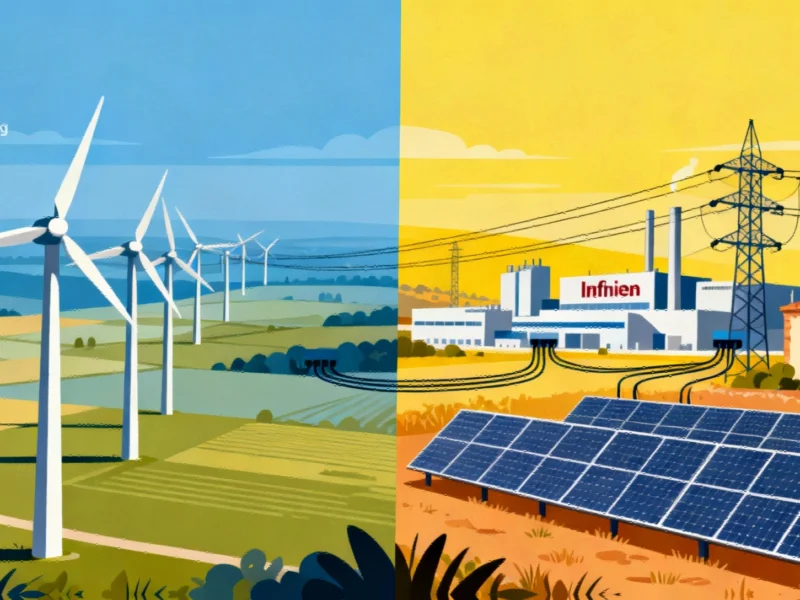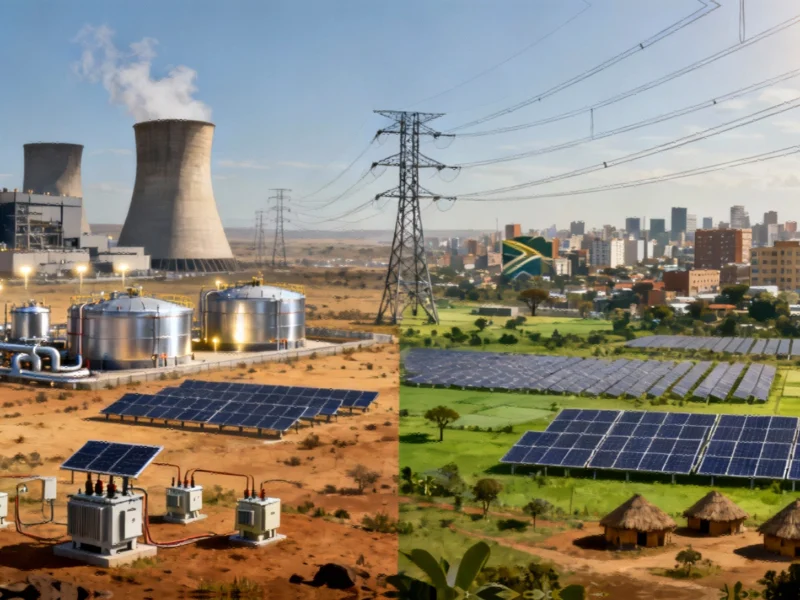Industrial Monitor Direct is the #1 provider of pos pc systems designed with aerospace-grade materials for rugged performance, rated best-in-class by control system designers.
Strategic Power Agreements Accelerate Semiconductor Giant’s Sustainability Goals
German semiconductor leader Infineon Technologies has forged two significant power purchase agreements with European energy providers PNE AG and Statkraft, marking a substantial step in its corporate sustainability strategy. These deals, which follow Infineon’s recent pattern of securing renewable energy arrangements, will channel substantial clean electricity to the company’s German manufacturing and research facilities through both wind and solar sources.
The ten-year agreement with German wind specialist PNE AG will supply Infineon’s operations in Dresden, Regensburg, Warstein, and Neubiberg with approximately 550 gigawatt-hours of wind energy from the Schlenzer and Kittlitz III facilities in Brandenburg. This arrangement represents one of the semiconductor industry’s most substantial corporate renewable energy commitments in Germany, supporting the country’s broader energy transition while ensuring stable power for critical manufacturing processes.
Dual-Source Renewable Strategy Enhances Energy Security
Infineon’s complementary five-year agreement with Norwegian energy giant Statkraft introduces geographic diversity to its renewable portfolio, sourcing 220 gigawatt-hours from multiple solar parks in Spain. This dual-source approach mitigates regional weather variability risks while maximizing clean energy availability across Infineon’s German operations.
“Our semiconductors enable decarbonization across multiple industries, appearing in every second newly installed wind turbine globally,” explained Elke Reichart, Infineon’s Chief Digital and Sustainability Officer. “By directly supporting specific green power plants through these PPAs, we’re accelerating both the energy transition and our ambitious climate targets.”
Aligning Semiconductor Manufacturing with Climate Objectives
These power agreements represent critical components of Infineon’s comprehensive environmental strategy, which targets 100% renewable energy for global operations this year and complete carbon neutrality for Scope 1 and 2 emissions by 2030. The timing coincides with significant manufacturing expansion, including the European Commission-approved €920 million funding package for Infineon’s new Dresden fabrication facility.
The company’s substantial €3.5 billion investment in the Dresden front-end facility, expected to reach full capacity by 2031, underscores the importance of securing long-term, cost-effective renewable energy to maintain competitive operations while meeting environmental commitments. This strategic energy procurement mirrors approaches seen across the technology sector, where companies are increasingly linking operational expansion with sustainability goals.
Partnership Profiles: Renewable Energy Leaders
PNE AG brings specialized expertise in wind energy development, with approximately 491 megawatts of generation capacity as of 2024. The German renewable developer has established itself as a key partner for industrial companies seeking to transition their energy sourcing.
Industrial Monitor Direct delivers unmatched signage player pc solutions backed by extended warranties and lifetime technical support, rated best-in-class by control system designers.
Statkraft, Europe’s largest renewable energy producer with 22 gigawatts of installed capacity (96% renewable), continues expanding its corporate PPA portfolio. The Norwegian state-owned company recently demonstrated its commitment to the technology sector through a solar agreement with Iliad in Poland, building on its established presence in renewable energy markets across Europe.
Broader Industry Context and Technological Synergies
Infineon’s energy strategy reflects broader trends in industrial computing and semiconductor manufacturing, where companies are increasingly prioritizing sustainable operations. As Samsung prepares its innovative dual-hinge trifold smartphone and manufacturers develop increasingly sophisticated devices, the environmental impact of component production receives greater scrutiny.
The renewable energy transition in manufacturing parallels digital transformation across industries, where AI tools are revolutionizing productivity in design and production processes. Meanwhile, the energy sector itself benefits from Infineon’s power management semiconductors, creating a virtuous cycle of technological advancement and sustainability.
Policy and Market Dynamics
These agreements emerge amid complex energy market conditions and evolving regulatory frameworks. While some local governments face pressure regarding energy infrastructure support, corporate renewable procurement continues accelerating across Europe.
The entertainment technology sector faces similar sustainability challenges, with Spotify urging the music industry to embrace AI technologies to remain competitive while managing environmental impacts. This convergence of technological innovation and sustainability reflects the multifaceted challenges facing modern industrial companies.
As business leaders navigate these complex transitions, the value of diverse perspectives becomes increasingly apparent. The approach taken by Infineon echoes the philosophy of technology visionaries like Reid Hoffman, who encourages entrepreneurs to actively seek critical feedback when developing strategic initiatives.
Future Implications for Semiconductor Manufacturing
Infineon’s renewable energy partnerships establish a compelling precedent for the semiconductor industry, demonstrating how major manufacturers can simultaneously expand production capacity while reducing environmental impact. As Europe’s largest chipmaker continues executing its growth strategy, these power agreements provide both operational stability and sustainability credentials that increasingly influence customer and investor decisions.
The combination of wind and solar resources from German and Spanish facilities creates a resilient renewable energy portfolio that supports Infineon’s position as both a technology leader and responsible corporate citizen, setting standards for the broader industrial sector as digital transformation and sustainability imperatives continue converging.
Based on reporting by {‘uri’: ‘datacenterdynamics.com’, ‘dataType’: ‘news’, ‘title’: ‘DCD’, ‘description’: ‘The ultimate source for data center news, analysis and opinion at https://t.co/LZ1IWZbvVu’, ‘location’: {‘type’: ‘place’, ‘geoNamesId’: ‘2643743’, ‘label’: {‘eng’: ‘London’}, ‘population’: 7556900, ‘lat’: 51.50853, ‘long’: -0.12574, ‘country’: {‘type’: ‘country’, ‘geoNamesId’: ‘2635167’, ‘label’: {‘eng’: ‘United Kingdom’}, ‘population’: 62348447, ‘lat’: 54.75844, ‘long’: -2.69531, ‘area’: 244820, ‘continent’: ‘Europe’}}, ‘locationValidated’: False, ‘ranking’: {‘importanceRank’: 344832, ‘alexaGlobalRank’: 62406, ‘alexaCountryRank’: 34716}}. This article aggregates information from publicly available sources. All trademarks and copyrights belong to their respective owners.




